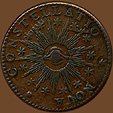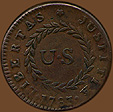obverse
 |
reverse
 |
|
obverse |
|
reverse |
|
|||
1783 Crosby 1-A Constellatio Nova - Pointed Ray
Obverse: CONSTELLATIO [five pointed star] NOVA ·
Reverse: LIBERTAS [five pointed star] JUSTITIA · 1783 · [in center] U · S
Weight: 132.3 g (8.57 grams) Diameter: 28.5 mm
Comments: Newman states this die is of lesser quality than the other dies in the series and suggest that although it was produced at the same Birmingham factory as the other dies, it was apparently produced by a different diemaker. The obverse can be determined as die 1 because one of the long rays is to the right of the A in NOVA. There is a mark observed on all examples of this coin from the center of the ray under the A in CONSTELLATIO continuing through a star and into the letter O, note that the mark has small denticles pointing toward the legend. According to Newman this was made by a denticle punch that inadvertently fell on the die before it was hardened. Newman has surmized the ark of the mark shows the denticle punch was made for use on a larger sized coin or medal. Another mark was also impressed into the obverse die; it can be seen from under the N, moving through the star and up to under the base of the first L in CONSTELLATIO.
The reverse can be determined to be die A because the letters U S are large (compare with die B below) and have a stop between them. Mike Ringo has shown some of the punches used on this variety are the same as are found on the "Georgius Triumpho" token, particularly at the 8 in the date where the top portion of the 8 is broken on the right side near the center and in the deformed 3.
Provenance: From the Robert H. Gore, Jr. Numismatic Collection.
obverse |
|
reverse |
| |||
1783 Crosby 1-A Constellatio Nova - Pointed Ray
Obverse: CONSTELLATIO [five pointed star] NOVA ·
Reverse: LIBERTAS [five pointed star] JUSTITIA · 1783 · [in center] U · S
Weight: 137.7 g (8.92 grams) Diameter: 28.5 mm
Comments: Another example of the previous coin. This coin is more worn. The planchet was slightly bent at the center (so that the obverse is convex and the reverse concave) so that the center of the reverse was weakly struck and numerous smal voids are present in the concave area. On the reverse the planchet also cracked at the rim from about 1:00 to 4:00 o'clock at JUSTIT in JUSTITIA.
Provenance: From the Robert H. Gore, Jr. Numismatic Collection.
obverse |
|
reverse |
| |||
1783 Crosby 2-B Constellatio Nova - Pointed Ray
Obverse: CONSTELLATIO [cinquefoil] NOVA ·
Reverse: LIBERTAS [cinquefoil] JUSTITIA · 1783 · [in center] U · S
Weight: 95.4 g (6.18 grams) Diameter: 26.3 mm
Comments: The obverse can be distinguished as die 2 by the use of the five pointed star in the legend and because one long ray points directly at the right foot of the A in NOVA. The reverse die B also uses the five pointed star in the legend and has the smaller sized U S without a stop between the letters.
Provenance: From the Robert H. Gore, Jr. Numismatic Collection.
obverse |
|
reverse |
| |||
1783 Crosby 3-C Constellatio Nova - Club Ray
Obverse: CONSTELLATIO [quatrefoil] NOVA ·
Reverse: LIBERTAS [quatrefoil] JUSTITIA · 1783 · [in center] U · S
Weight: 132.5 g (8.58 grams) Diameter: 27.2 mm
Comments: Obverse die 3 is easily recongized in that a L is missing in Constellatio. This is a heavy or club ray variety. The long rays have blunt convex ends rather than fine points at their tips. In die c one ray is at the N in NOVA (other varieties have the ray to the left of the N). The reverse die C can be distinguished in that the wreath has 23 pair of leaves, while the other varieties have 24 pairs. Also, this reverse has U S in smaller letters but with a stop between them (as is usual with the large letter varieties).
Provenance: From the Robert H. Gore, Jr. Numismatic Collection.
| Nova Constellatio Patterns | Section Contents | Constellatio Nova Coppers 1785 |
|
For viewing tips and information on optimal computer settings click
here.
For questions or comments contact Special Collections by: |